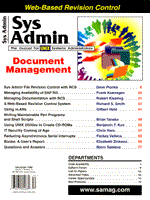
Editor's Forum
Everything from the Bible to The Blues means different things to different people. To most people, for example, Otis Redding's blues tune, "Dock of the Bay," was simply a song about a man trying to find work. Others, however, might see a different set of clues. Let's explore the lyrics from that alternate perspective. "Sittin' in the mornin' Sun" - obviously refers to a non-programmer at Sun Microsystems, because programmers seldom arrive in the morning. "I'll be sittin' till the evening's done" - seems he has to work late, as well. Not atypical for Silicon Valley. "Watchin' the chips roll in" - might he be on the UltraSPARC production line? "then I watch 'em roll away again," - or in shipping, perhaps? However, "Sittin' on the Doc of the bay" is the real clue. He is obviously a document management expert, frustrated by others failing to grasp the significance of his efforts, as evidenced by: "Sittin' on the Doc of the bay wastin' time..." Contrary to this twisted interpretation of Mr. Redding's work, document management is not a waste of time, and is actually well understood, particularly by the folks in finance. For software developers, document management is how they go about controlling revisions to application source code. For the people in Human Resources, a similar meaning. It's just that they are managing changes in company-policy documentation - easier to read, but more difficult to understand than C code. In both cases, document management is the process by which modifications to business-critical documentation can be tracked, attributed, and rolled back, if necessary. A tedious, but crucial aspect to all but the most casual of projects. What gets the folks in finance excited, however, is the company Web site. Rightly, document management experts see the Web as the focal point and best example of what they strive for: consistency and reuse. Properly applied, a good document management architecture ensures that references to a particular part, process, or procedure are consistent throughout the company's documentation, marketing brochures, and other published materials. This same architecture enables the reuse of technical documentation and marketing materials as source documents for the company's Web site. Thus, the accuracy of the information can be improved, and the potential effects of human error are minimized. The financial benefit of document management applied in this manner is the elimination of the expense of rewriting the material for each type of output. User documentation, marketing materials, and Web content all can share the same source document. Only minor editing and reformatting is required for the particular medium of publication - manual, glossy brochure, or Web page. Systems administrators are often at the center of document management efforts, or, at least, should be. Who else but the sys admin understands the needs of the different departments within the organization, and how the files each department stores can best interrelate? And, who but the sys admin will implement the document management architecture on the company's systems and ensure the right levels of connectivity between the disparate parts that make up the architecture? So, although the motivational poster of the child on the "trainer seat" chided, "The job isn't done until the paperwork is complete," the document manager would assert that the paperwork (real or electronic) *is* the job.
Sincerely yours, |